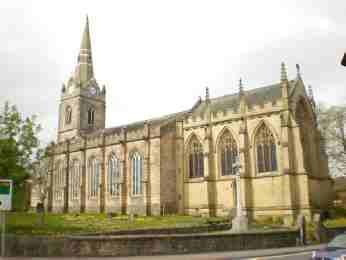




 In 1471 Holy Trinity was built because the need for a church other than St. Chad's in Rochdale was becoming more essential. The local population increased and St. Chad's served all the people between Rochdale and Todmorden. The Todmorden folk used either Halifax, Heptonstall or Rochdale.
In 1471 Holy Trinity was built because the need for a church other than St. Chad's in Rochdale was becoming more essential. The local population increased and St. Chad's served all the people between Rochdale and Todmorden. The Todmorden folk used either Halifax, Heptonstall or Rochdale.
An application for a licence was made the to the Abbot of Whalley, who granted one on condition that the building of the church was paid for by public funds and that the chaplain appointed had to be paid for out of the local coffers. The chaplain then had to repay to the Abbot of Whalley, two tenths of this income.
The chapel was built nearer to the river than today's building and it was called Little-
In 1660 Holy Trinity was made into a Parish Church and supported a congregation of 272 families. It continued to thrive, but marriages were still performed at St. Chad's, as an extra charge was made for using any other church than the mother church of the parish. It was common practice for couples to walk over the moors from Todmorden and Littleborough to St. Chad's with their friends, to be married before morning service. They would then have a short rest at a pub in town, before setting off back for home, probably in a merry state.
The influential Halliwell family was much involved with Holy Trinity and Theophilus made money available for a schoolmaster and at a later date, some time around 1697, his brother Richard built the school in Ealees Lane. It was funded by subscription from the Halliwell family who were local landowners and it was run as a church school. When it first opened it took 10 pupils. It was the only school at that time between Littleborough and Todmorden.
In the 1700's the church fell into disrepair and only 182 families now attended. It was rebuilt in 1817, possibly for the second time and was paid for by public subscription. The Endowed school carried on with its work and scholars paid 1d for their Sunday morning reading and writing tuition.
Mr. Lawrence Newall of Town House paid for a new steeple to be built in 1860, so that he could see his gift from his home.
In 1872 Dr. Salts was appointed as vicar and he injected a new enthusiasm into the church and school. After a few hurdles were overcome, a new chancel foundation stone was laid in 1889, which added 57 new seats to the church. The Parish Council had previously turned down the offer of the sum of £4, 000 made in 1876 by the mill owner, Mr. W. Law, for a new church to be built. The church continued to grow with Dr. Salts as its vicar. He served at Holy Trinity until 1911, a total of 38 years. After he retired, another vicar, Rev. A. W. Gaskell, served the church for 40 years.
Very little has changed since 1889. A memorial cross was placed in the churchyard in honour of the fallen of World War One and the original graveyard was closed in 1940 as it was full. The stones have since been laid flat, making for easier maintenance and gives the churchyard an open aspect.
